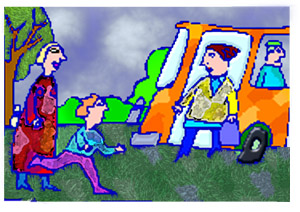 Management at Toronto’s Leslie Street Spit: Restoration or a Distant Relative?
Management at Toronto’s Leslie Street Spit: Restoration or a Distant Relative?
I recently had the chance to visit two sites in Toronto where ecological restoration work is being carried out–High Park’s black oak savannah and the Leslie Street Spit. The environmental management approaches at these sites are quite different, and provide an interesting opportunity for exploring a central question in the field of restoration ecology, namely: what activities warrant the title of ecological restoration? A variety of motivations currently form the basis for carrying out restoration efforts, from attempting to restore a site to an approximation of its original, historical condition to centring restoration instead on specific conservation priorities (e.g., recovery of species of concern).
The management strategies in High Park and the Leslie Street Spit provide good examples of these two quite different bases for restoration. In High Park, the primary goals of restoration centre on protecting the existing at-risk black oak savannah ecosystem and restoring this ecosystem to its historical condition as much as possible in the highly-urbanized setting in which the site exists (pretty much downtown Toronto).
The basis for this restoration effort, then, is history: attempts are being made to re-establish plants and plant communities that historically existed at the site, and to reinstate natural (i.e., historical) disturbance regimes such as fire, which are crucial in maintaining appropriate plant community dynamics. Management at High Park can be thought of as an example of classic restoration, in which the site itself provides the historical basis upon which management plans are based.
Management activities at the Leslie Street Spit (a man-made landform extending about 5 km from Toronto’s Lake Ontario shoreline) are based on quite a different approach. Restoration at this site is centred on the recovery of target species, especially wildlife species of concern. Without any long-term natural history to call its own, the Leslie Street Spit itself provides no historical basis upon which to develop restoration plans and targets; as such, its management raises two interesting questions:
1) Can the creation of ecosystems that did not previously exist at a particular site truly be called restoration?
2) Does geography, and scale in particular, matter in the definition of restoration, and does it help to qualify question 1?
Definitions may help to answer these questions. According to the Society for Ecological Restoration International, ?Ecological restoration is the process of assisting the recovery of an ecosystem that has been degraded, damaged or destroyed? (1). In the case of the Leslie Street Spit, the actual medium on which restoration is based (a mass of construction waste and imported subsoil) has no history of having been degraded, damaged, or destroyed. As such, it could be said that management programs here are not technically assisting in the site’s recovery: one cannot recover what did not previously exist. In this sense, it may seem more appropriate to term current management activities at the Spit as ecosystem creation or ecological engineering rather than ecological restoration.
Addressing the second question above–that of the importance of geography and scale in restoration–may help resolve the issue of whether or not activities at the Leslie Street Spit can fairly be termed restoration. While the precise geographical location of the landform that is now the Leslie Street Spit was historically an aquatic ecosystem (part of Lake Ontario), nearby sites likely hosted (and still host) plant and animal communities very similar to what is being created in the management units on the Spit. In quibbling over the appropriate use of the term restoration, the question here becomes: what is meant geographically by the terms ?site? and ?ecosystem?? To make a case that management activities at the Spit should be considered ?restoration?, it could be said that current efforts at this particular site are based on restoring characteristics of the broader ecosystem in which the Spit is found. The Leslie Street Spit therefore offers an interesting case in which determining whether or not the term restoration is appropriate is influenced by the geographic scale at which one chooses to define site and ecosystem, and thereby restoration and recovery.
The above discussion highlights some of the complexities involved in the language of a field as necessarily diverse and adaptive as ecological restoration. High Park and the Leslie Street Spit provide interesting cases for exploring the terminology and communication bases of ecological restoration. The remaining question, given the exciting–and in the case of the Leslie Street Spit, dramatic–conservation gains achieved by both projects within an otherwise rapidly-degrading regional ecosystem, is the following: what has greater merit–spending one’s time critiquing the linguistic basis of restoration, or getting one’s hands dirty putting together appropriate habitat at any site where the opportunity arises, regardless of the name given to the activity?
(1) Society for Ecological Restoration International, 2004. ?The SER International Primer on Ecological Restoration.? Retrieved June 2, 2007, from http://www.ser.org/content/ecological_restoration_primer.asp
